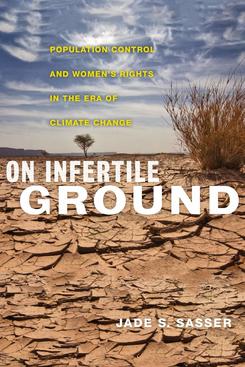
Over the past 100 years, the popularity of population control in the United States has ebbed and flowed. Once considered a responsible way to safeguard the planet and ensure its future viability, population control was later revealed as a coercive tool used to limit the reproductive freedom of low-income and minority groups.
Jade S. Sasser, an assistant professor of gender and sexuality studies at the University of California, Riverside, has spent nearly a decade studying the history of population politics and how they’re interpreted today. According to her, population control is far from a thing of the past; instead, some of its core messages have been repackaged to appeal to a younger generation of American activists.
The resulting narrative links population trends to environmentalism and sexual agency, positioning “empowered” women as key crusaders in the fight against climate change. If women are encouraged and given the materials to control and limit their reproduction, or so the thinking goes, both they and the planet will reap the benefits.
But there’s a problem, Sasser said. Certain women remain disproportionately targeted by such a narrative, the bulk of them poor women living in the Global South, or countries in Africa, Latin America, and developing Asia.
Sasser’s firsthand experiences with young women in the Global South — and their American activist counterparts — form the backbone of her new book, “On Infertile Ground: Population Control and Women’s Rights in the Era of Climate Change” (NYU Press). Described by its author as a “cautionary tale,” the book takes a critical look at the positioning of population growth as a source of climate crisis.
“My hope is that the book will help people understand these issues as parts of a more complex system,” Sasser said. “Connecting population control and the environment might come across as common sense, but what we think of as ‘common sense’ is never actually common; in this case it’s shaped by people like scientists who produce the information we learn in school, and what we see and hear in media. For decades, policymakers, scientists, and environmentalists, in particular, have worked hard to frame population control as common sense.”
A former Peace Corps volunteer in Madagascar, Sasser spent nearly two years observing a series of trainings and workshops on population advocacy, including those run by a now-defunct Sierra Club program known as the Global Population and Environment Program, or GPEP. The program targeted primarily young American women for membership “through upbeat approaches linking youthful energy, the language of women’s empowerment and justice, and policy-relevant science,” Sasser wrote.
Despite being based in the U.S., the program concentrated its efforts on women in the Global South. It emphasized the importance of what Sasser calls “sexual stewardship” — achieved through contraceptive use and other family planning techniques — to both women’s overall empowerment and environmental relief. But when hard data is taken into consideration, Sasser said, the flawed simplicity of the GPEP’s approach to countering climate change becomes glaringly obvious.
“The countries that contribute the most greenhouse gases to the atmosphere every year are not those with the highest fertility rates,” she said. “As of 2011, China, the U.S., Russia, India, and Japan emitted the highest greenhouse gases every year; each of these countries has low fertility rates” when compared with those of the countries that population advocacy groups like the GPEP tend to focus on.
What’s more, in those same high-fertility countries — places like Nigeria, Tanzania, and Ethiopia — national greenhouse gas emissions don’t even rank in the top 75 worldwide. At best, the disparity indicates a deeply misguided attempt to combat climate change by placing the onus for doing so on Global South women.
In Sasser’s view, the aims of advocacy groups like the GPEP ignore the complex realities and long-term goals of the young women they claim to serve.
“Global South women are presented as the homogenous poor, simultaneously burdened by environmental problems, poverty, and their own excess fertility,” she said of sexual stewardship discourses like the one put forth by the GPEP. Such portrayals fail to paint an accurate picture of the young women Sasser met during her time in Madagascar, where she worked in a village as a community health advisor, teaching sex education to an audience of mainly teenagers.
“I was in my mid-20s during my time in the Peace Corps, and suddenly I was surrounded by young girls and women who had already been pregnant and breastfed — many had already had abortions at some point — and I realized that my knowledge was completely inadequate in comparison to their real-life experiences,” she said. “I needed to learn from them.”
Her experiences with those same Malagasy women later inspired Sasser to read deeper into the history behind modern population control, which she said began to resurface as a concept increasingly tied to climate change in the mid-2000s. Her research revealed population control’s roots in 16th- and 17th-century Europe, as well as its later synthesis into a coherent theory, often used to discredit the importance of social welfare policies, by Thomas Malthus.
She also dove into population control’s American history, tracing its mid-century domestic origins to a series of efforts to distribute contraceptives in other countries as part of international aid packages. Meanwhile, as birth control became a hot commodity in the U.S., Sasser said, “where middle-class white women were struggling for the right to limit their fertility, poor women and women of color were fighting forced sterilization and other imposed means of coercive fertility regulation.” Under contemporary population control narratives, what remains at stake for women in the Global South isn’t much different.
Sasser said she remains a strong supporter of all women’s access to contraceptives and family planning services, as long as they’re situated “within a context of comprehensive sexual and reproductive, and broader, health services.” It’s the reframing of population control as a social justice movement she finds fault with. Still, she’s not entirely surprised by the movement’s draw among young activists, many of whom prioritize individual actions as solutions to large-scale environmental problems.
“When it comes to climate change, it’s much easier to point to someone on the other side of the world and say it’s their problem,” Sasser added. But such a strategy ignores larger drivers of environmental destruction: namely, state- and corporate-led resource extraction and pollution, the effects of military action and occupation, and the fossil fuel consumption practices of the wealthy, to name just a few.
If young Americans truly wanted to feel like they were making an impact, Sasser added, they’d focus on adjusting their own behaviors and consumption patterns while advocating for large-scale changes too. Simple changes such as eating fewer meat and dairy products, taking public transportation, shopping locally and ending our dependence on fast fashion are accessible ways to contribute to the planet’s greater good.
“It’s lazy to say that population control will solve climate change,” Sasser said. “This is really simplistic thinking that doesn’t begin to address the complexity of resource consumption, not to mention the complexity of population dynamics; it also lets powerful, problematic actors like militaries and oil corporations off the hook. Let’s not be lazy in our thinking or in our actions: Reducing human numbers alone has never been the solution.”
Sasser’s research for “On Infertile Ground” was supported by the National Science Foundation and the Ford Foundation.





